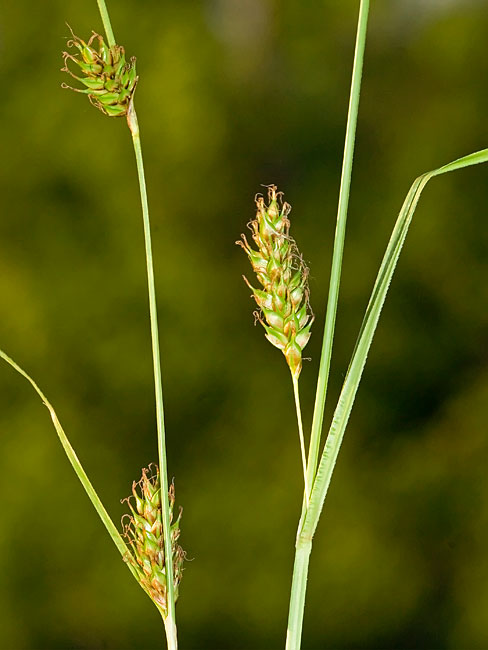Carex distans
Removes spiked sedge ( Carex distans )
The remoteness spiked sedge ( Carex distans ) belongs to the family of the Sedge family ( Cyperaceae ). It is pollinated by the wind ( anemophily ) and the seeds also spread by the wind ( Anemochorie ). It is a Mixed -spiked sedge from the subgenus Carex.
Features
The remoteness spiked sedge is an evergreen perennial, herbaceous plant, the plant height of 20 to 60, rarely to 100 cm reached. The plants grow densely Horstig and do not form spurs. The stems are triangular, smooth and arched curved.
The leaves are gray-green, rough on the upper side and 2 to 3 mm wide. In the end they are pointed suddenly. They are significantly shorter than the stems. The ligule measures 2 to 3 mm. The abdominal wall of the vagina has a trockenhäutiges appendage. The basal leaf sheaths are brown and slightly zerfasernd.
There is one male and two to three female ears. They are up to 3 cm long, erect to nodding and are standing apart. The lower is stalked and sits roughly in the middle of the stem. The bracts have long sheaths and are usually much longer than the spikelets, but shorter than the whole inflorescence. The bract ovate - mucronate and rust-colored with a green center strip. It stands upright and is ciliated briefly at the end. It is shorter than the fruit. ( Flowering period is May and June. )
This is a nutlet and 4 to 5 mm long, glabrous, dull, yellow-green with brown spots or braunspitzig. She is suddenly narrowed into a spreading Schnabel, who is inside and outside rough. She has three scars.
Dissemination and locations
The remoteness spiked sedge is found in the hot temperate zones of the northern hemisphere widespread.
It grows on moist meadows, marshes and Kalkflachmooren. It is salt- loving and prefers to grow on heavy soils. In the coastal region often grows in beach meadows. Inland, it indicates salt and gypsum soils. Can be found in the montane altitudinal zone and rises to 2000 m.
Phytosociological it is a kind of beach Elke meadows ( Armerion maritimae ), the Molinion caeruleae and Caricion davallianae.
Documents
- Siegmund Seybold (ed.): Schmeil Fitschen - interactive ( CD -Rom ), Quelle & Meyer, Wiebelsheim 2001/2002, ISBN 3-494-01327-6
- D. Aichele, H.-W. Schwegler: Our grasses. 10th edition, Franckh cosmos, Stuttgart 1991, ISBN 3-440-06201-5, p 176










